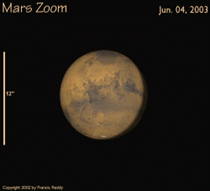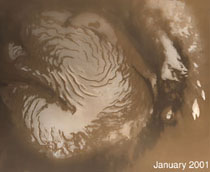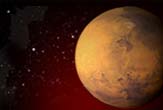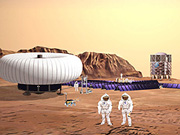| (insert your NIE or newspaper logo here) |
Weekly Online LessonOnline Lesson ArchiveGrade Level: 6-12
|
Closing In On Mars
 Modern
humans haven't seen Mars like this for about 60,000 years, when they
were living primarily in Africa and Neanderthals dominated Europe.
Modern
humans haven't seen Mars like this for about 60,000 years, when they
were living primarily in Africa and Neanderthals dominated Europe.
This Wednesday, August 27, the planet Mars will again be only 34,646,418 miles away from Earth — that's five times closer than where it was just six months ago.
For amateur stargazers, the planet's unusual proximity is great news. Although Mars is quite visible to the naked eye, appearing much brighter than normal, inexpensive telescopes can zoom in for a closer look at some of its mountains and canyons.
But many scientists, particularly those at NASA (the National Aeronautics and Space Administration), have had their eyes on Mars for a long time. Since as early as 1960, experts have been developing orbiters, landers and rovers to study the planet in detail and as continuously as possible.
 Based
on NASA's research, many scientists believe that Mars may have previously
supported an atmosphere, and possibly carbon-based life forms, similar
to Earth. This means that it could do so again in the future.
Based
on NASA's research, many scientists believe that Mars may have previously
supported an atmosphere, and possibly carbon-based life forms, similar
to Earth. This means that it could do so again in the future.
Some experts think that the red planet could be "terraformed," meaning transformed into an Earth-like planet, and developed as the first human other-world colony. In fact, beginning around 2007, NASA expects to launch several Mars missions that will transport habitat modules and other equipment to its surface. By 2016, a human flight crew will make the four to five-month journey for on-the-ground exploration.
Can you imagine what it could be like 284 years from now, when the two planets will again orbit only about 35 million miles apart? Humans may see cities and farms on the opposing planet's surface!
Since the concept of colonizing Mars is no longer a science fiction fantasy, this week you'll explore Mars and discover what we terrestrials are doing to transform the red planet into our future living room.
A Planetary Tour
 Begin
by buzzing through our solar system with The Planetary Society's Solar
System Guide. (Feel free to review the Solar
System Primer for a basic introduction first.)
Begin
by buzzing through our solar system with The Planetary Society's Solar
System Guide. (Feel free to review the Solar
System Primer for a basic introduction first.)
Take a spin around Earth, Mars (including the Missions to Mars page), and one or more other planets like Venus or Saturn.
For more visual comparisons, visit NASA's Welcome to the Planets website and browse the image galleries.
How do the planets compare in their atmospheric and geological features? Did you notice features on one or more planets that are similar to ones on Earth? How long is each planet's day and year?
 Now
next let's get up-close to the red planet with NASA's Mars
Exploration Program (MEP).
Now
next let's get up-close to the red planet with NASA's Mars
Exploration Program (MEP).
Start with the Mars in the Night Sky section, and read the feature titled, Mars Closest Approach. Download the coloring sheet for later, if you'd like.
Also, read about Mars Opposition and play the Mars and Earth in Orbit animation. Learn about the Mars Retrograde, and find out where and when Mars will appear in your region's night sky.
How is the solar orbit of Mars different from that of Earth? Why exactly does Mars appear to follow a funny path across the sky?
 Also
at the MEP site, check out All
Missions to Mars and discover how we've been getting closer
to Mars in other ways. Browse through some of the Orbiters,
Landers and Rovers
built by scientists to study the planet, including the Mars
Express.
Also
at the MEP site, check out All
Missions to Mars and discover how we've been getting closer
to Mars in other ways. Browse through some of the Orbiters,
Landers and Rovers
built by scientists to study the planet, including the Mars
Express.
Make sure to look into the future of travel and development on Mars as well, including airplanes and subsurface explorers.
Life On Mars
 All
of this research is critical to colonizing Mars. To see how today's
efforts will lead to future plans, let's stop over at the MEP's Science
lab and check out the Four Science Goals for Mars Exploration
related to Life,
Climate, Geology,
and Human
Exploration.
All
of this research is critical to colonizing Mars. To see how today's
efforts will lead to future plans, let's stop over at the MEP's Science
lab and check out the Four Science Goals for Mars Exploration
related to Life,
Climate, Geology,
and Human
Exploration.
How does understanding the planet's past and present conditions help scientists figure out how humans could live there in the future? What types of characteristics (biological, atmospheric, or geological) are still largely unknown?
It's one thing to study a planet, and another to actually live there for a while. Try imagining what Mars could be like in the future, including sustainable human settlements. To help you visualize the possibilities, see How Terraforming Mars Will Work.
Read the Introduction then the Why Mars? and Creating a Martian Greenhouse sections. How does today's Martian atmosphere compare to that of Earth? What makes Mars the most ideal candidate for terraforming compared to others that were considered? What are some of the proposals for "greenhousing" Mars? Which method might be the most promising and why?
How could the conditions on Mars influence non-scientific aspects of life? For example, in what ways might the presence of two moons inspire local artists and musicians? How might the planet's natural resources be used? What kinds of businesses might be profit there? What would relationships between governments there and on Earth be like?
Newspaper Activities
Browse Targetnewspaper for articles about Mars. Stories may be about the planet itself, like how close it is to Earth, or about related research and exploration. What in the news highlights the natural state or features of Mars? In what new ways are scientists studying the planet? How does their research add to our knowledge of its global systems? How about to our future plans for habitation there?
© Copyright 2003
Learners Online, Inc.
